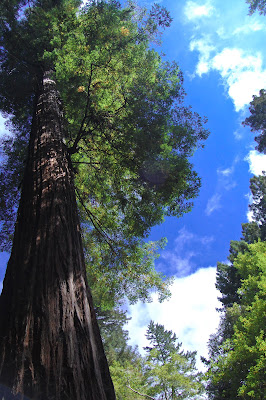I have also spent the last year examining prayer and worship and how we perceive the movement of God on Sunday mornings.I'm thinking even more about it lately as I struggle to feel at home.
I thought I'd revive this post because its been on my mind, and then maybe I'll go for a walk in the woods.
Emerson and Prayer
22 November, 2008
"Prayer that craves a particular commodity,—any thing less than all good,—is vicious. Prayer is the contemplation of the facts of life from the highest point of view. It is the soliloquy of a beholding and jubilant soul. It is the spirit of God pronouncing his works good. But prayer as a means to effect a private end, is meanness and theft. It supposes dualism and not unity in nature and consciousness. As soon as the man is at one with God, he will not beg. He will then see prayer in all action. The prayer of the farmer kneeling in his field to weed it, the prayer of the rower kneeling with the stroke of his oar, are true prayers heard throughout nature, though for cheap ends."
I struggle with parts of this passage (which I'll get to later), but I appreciate his definition of prayer, "the beholding and jubilant soul,...the spirit of God pronouncing [H]is works good."
I think so often we make prayer really small--what we have in the postmodern me-centered Church starts to sound like a conversation between 2 people, which is prone to the viciousness and selfishness of Emerson's concern.
By definition, prayer is the soul's communication with the master and creator of the universe, permissible through the redemptive work of Death and Resurrection. I think we too often get the scale wrong, which leads us to seeking the "private end," resulting in "meanness and theft." Prayer becomes a wish-list, or a script, or a manufactured emotional validation for an ungodly cause. When we approach prayer as a "conversation," there isn't much to keep us from projecting fallen human sentiments on something wholly and holy Other--because a conversation presumes we do the talking.
In this sense, maybe we get the scale of worship wrong, too. In church, we carefully select songs, with particular rhythm and notes, to call out specific emotions and intellectual themes. Maybe this is too controlled. Maybe we need to better remember we are part of a much larger "conversation".
Prayer and Worship really happen when all of creation lives according to the fullest measure of its purpose.
This is how "prayer of the farmer kneeling in his field to weed it, the prayer of the rower kneeling with the stroke of his oar" could be heard "throughout nature".
What was the first worship like? What were the first prayers? What was prayer and worship like before power structures? Before perverted collectivism? Post-modernism? Tithes and small-groups and potlucks and simple guitar chords and Christian Radio? Before we forced it into our tiny practices and manicured liturgies? Before we made what connects prayer and worship the "me" of it all?
Dillard and Emerson have both driven me to seek examples in the natural landscape. I find an illustration of the true, simple prayer and worship in the trees of my daily routine.
The trees reach deep into the surface of the earth--depend on it to live and grow--to where they hold up the sky. The enormous trees on our school's campus are so big they seem to fully support the great blue canopy. And if the canopy fell, it could be a great wall of water, a tsunami that wiped out everything, the walls of the Red Sea held in place by the wooden staff of Moses.
We need the trees above our front doors, above the bell tower, above the dorm, the dining hall, the classroom building, or the sky might cave in and we'd be lost. These trees are pillars, sentinels. I walk among them, but they are separate from me. They live according to their great purpose, connecting the earth to blue infinity.
I can imitate the trees: raise my hands like branches in prayer and worship or I can climb a tree like Zaccheus to see Jesus.






No comments:
Post a Comment